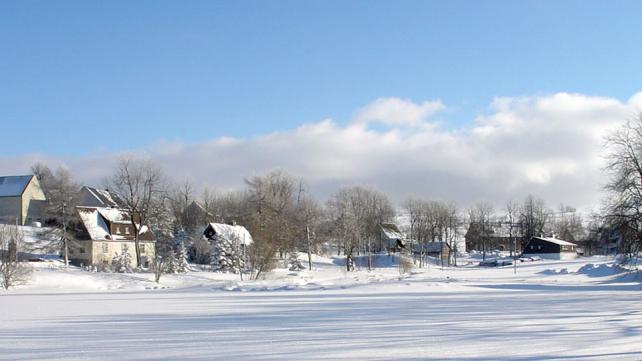I feel a little lethargic today and wonder why. Perhaps because I had a rough day yesterday, but it could also be SAS--Seasonal Affective Disorder. That's a fancy term for a not uncommon condition that sort of takes the life out of you. Wintertime is especially the time for it, the time when there is little sun and light in general. I don't usually think of myself as having it, but our oldest son in California is definitely afflicted by it. That's a major reason he lives in that state of for-ever-sunlight.
I am forwarding an article explaining this condition that is published by the Muslim ministry called "Sound Vision: Helping Tomorrow's Muslims Today." The website is found down below. Give it a read if you think you might be affected.
And thanks to author Meha Ahmad. You've done us all a favour with this article. It is clear and to the point.
How to fight Seasonal Affective Disorder

During the winter, we are slaves to the cold. The days are shorter, the nights are longer, and most likely you may not get as much out of your days as you did during the summer months.
As winter rolls on, millions of people experience some range of Seasonal Affective Disorder (SAD), a mood condition that is otherwise known as “the winter blues.” A person will have normal mental health throughout the year, but experience slight or moderate symptoms of depression. Luckily, you can change your situation.
The Cause
While the exact cause of seasonal affective disorder is yet to be determined, SAD is believed to be related to light. And in winter, the daylight is significantly reduced, disrupting your body’s internal clock (which can lead to depression).
SAD can also be caused by the pineal gland—a gland that depends on sunrises and sunsets and helps us develop a daily rhythm—secreting too much melatonin, a hormone that affects sleep patterns and mood.
Serotonin levels also change during the winter, often dropping when exposure to sunlight is reduced. A reduced amount of serotonin, a brain chemical that affects mood, can also lead to depression and contribute to SAD.
Symptoms
The symptoms of SAD may vary. They include, but are not limited to, the following:
- Depression
- Listlessness, lack of energy
- Morning sickness
- Cravings for junk food, sugars, carbohydrates; weight gain
- Consistently oversleeping and difficulty waking up
- Hopelessness
- Anxiety
- Loss of interest in once-enjoyed activities; social withdrawal
- Difficulty maintaining focus
How To Fight SAD: Six Winter Blues Busters
1. Resist hitting the snooze button.
We get it, it’s cold and gloomy outside. Your blanket is warm, and the floor is cold, so you think the logical answer is to stay in bed and sleep in. But we’re telling you: RESIST. Starting your day at your normal schedule is the first step to fighting SAD.
2. Exercise.
You’ve heard that working out gets endorphins—that hormone that gives you a rush, like a “runner’s high”—right? Well, this is especially helpful when fighting off the winter blues. Cardio and strength training will get your blood flowing, help you be more alert and feel more productive throughout your days.
3. Eat healthy.
This tip works year-round, but you don’t want to forget it during the winter. Winter may cause your serotonin levels to drop, causing your body to crave junk food, high in carbohydrates and sugars (desserts, junk food, soda) because they raise serotonin levels. But what you should really be eating instead are foods higher in protein and fiber. Know the cravings for what they are and opt for healthy choices instead. It will help you fight off lethargy.
4. Take your vitamins.
Have you considered taking multivitamins? Every day, take one that contains Vitamin D—a bone-strengthening vitamin that your body usually makes when exposed to sunlight. But with less daylight available in the winter, turn to a multivitamin for your energy.
5. Embrace the season.
Many of us do not look forward to the winter season; it’s cold, damp, and dark outside, leading many to dread it. But embrace it instead! Take up a winter-related activity—skiing, sledding, winter hiking, ice skating, snowball fights, making snowmen, etc.—that will help you look forward to the season rather than shrink away from it and go into hibernation.
6. Get more sun.
Light therapy is doctor recommended for fighting SAD. The change in light exposure will stimulate a change in the levels of chemicals and hormones, particularly serotonin, that affect your mood. Exposure to bright artificial light improves SAD symptoms, but nothing beats the real thing. In fact, did you know that an hour of aerobic exercise outside has the same therapeutic effects as 2 ½ hours of artificial light exposure indoors?
Going outside first thing in the morning, or even just pulling back the curtains and letting the sunlight stream in will greatly combat seasonal affective disorder. Taking a brisk early morning walk is a triple hit: you’ll get exercise, expose yourself to the sunlight (lightening your mood) and help your body manufacture Vitamin D.
https://www.soundvision.com/article/how-to-fight-seasonal-affective-disorder
No comments:
Post a Comment